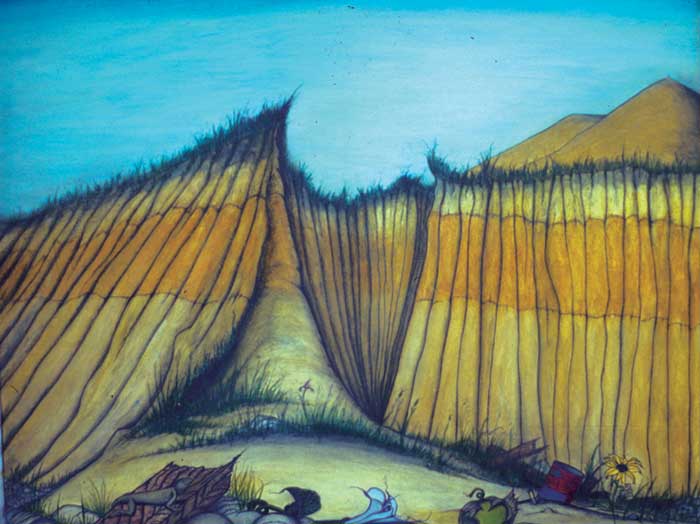18.
The Cliff (at El Fornio)
THE CLIFF SAT AT THE edge
of the canyon like a four-layered cake. Above the top layer, a crown
of grass grew like a crop of hair, green against the sky.
The first layer, under the grass crop, was a short charcoal
black band of topsoil, made of dead vegetation and the ash of
grassfires. Next was a mix of white chalk and yellow limonite, all
sedimentary deposits from old ocean bottoms. Then sat a band of hematite,
red iron-oxide from a previous world’s alluvial run. Lastly, a
taller band of yellow earth sat: diatomaceous and yellowish limonite.
At the bottom of the cliff, where the dust of the four bands
fell to the bottom of the ravine, was the detritus of human activity.
There were boards and rusted rebar twisted into the creek
cobble. A yellow daisy grew by itself next to a red and rusting can
of opened El Fornio Brand Dolpin Meat™.
In front was a damaged, open-husked tomatillo—green
as day—that had fallen off of a truck out of town. Up the incline,
at the base of the cliff, grew a California Wild Iris, its petals yellow
and purple.
Along a splintered, dried mahogany board a blue-belly
lizard, a.k.a. Western Fence, sat, doing push-ups, before he darted
into the cobbles.
Datura grew healthy in the late Spring, and not far from
the dolphin can lay a bell of the flower, attached to a deep green vine
with tobacco-like leaves, the bud of a prickly-laced ball sat snug up
to the part where the leaf and the vine parted. The petals of the datura
were white with purple tinges, eight corolla accented and measured the
bud at its curled points. It was the host of a religion, but nobody
noticed the blooming datura sitting by itself in the sun at the bottom
of the cliff.
Not nowadays.
|





